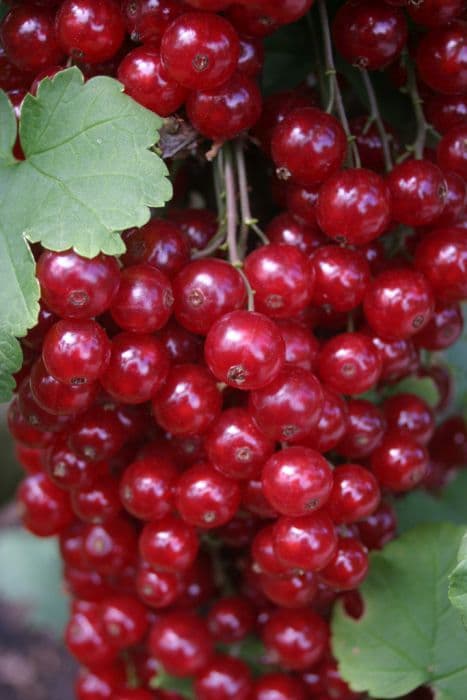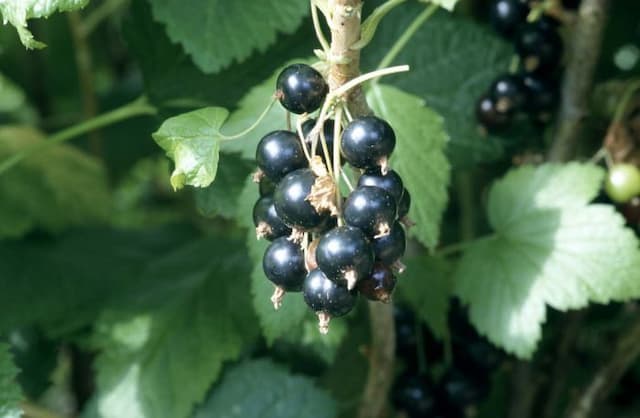Alpine currant Ribes alpinum

ABOUT
The plant known as mountain currant is a deciduous shrub that is noted for its lush, green foliage. This plant boasts a dense and bushy appearance, with multiple branches growing in a clumping manner. The leaves of the mountain currant are simple and lobed, typically taking on a heart-shaped appearance with a rich green color that can turn reddish or purple in the fall, adding a touch of autumnal vibrancy to the plant. Small, unassuming flowers emerge in clusters during springtime, which can be yellowish-green or red in color, depending on the variety. These tiny flowers are not especially showy but do contribute to the plant's overall attractiveness by providing some early season interest. As the growing season progresses, the flowers give way to clusters of spherical berries. The berries start out green and as they mature, they usually turn a bright red or sometimes a more subtle shade of dark red or almost black. These fruits are favored by birds and can add a decorative touch to the shrub. Mountain currant's relatively modest and well-structured appearance, coupled with its dense leafy growth, makes it a popular choice for a natural hedge or a border in garden settings. Its ability to provide multi-seasonal interest, from the spring flowers to fall foliage and berries, ensures that it will contribute various aesthetic appeals throughout the year. While small and inconspicuous, the flowers attract pollinators, adding ecological benefits to its visual charms.
About this plant
 Names
NamesFamily
Grossulariaceae.
Synonyms
Alpine Currant, Mountain Currant, European Red Currant.
Common names
Berisia alpina, Grossularia alpina, Ribes pyramidale.
 Toxicity
ToxicityTo humans
Ribes alpinum, commonly known as alpine currant, is not typically regarded as a toxic plant to humans. There are no well-documented cases of poisoning from ingesting parts of this plant. However, it is always advisable to exercise caution and avoid eating any part of ornamental plants without proper identification and knowledge about their edibility and potential effects.
To pets
Alpine currant (Ribes alpinum) is not known to be toxic to pets. There are no significant reports of this plant causing poisoning in animals. As with humans, it is generally recommended to prevent pets from consuming plants not intended for consumption, as individual animals might have sensitivities or allergic reactions.
 Characteristics
CharacteristicsLife cycle
Perennials
Foliage type
Deciduous
Color of leaves
Green
Flower color
Greenish-yellow
Height
3-6 feet (0.9-1.8 meters)
Spread
3-6 feet (0.9-1.8 meters)
Plant type
Shrub
Hardiness zones
2-8
Native area
Europe
Benefits
 General Benefits
General Benefits- Landscape Ornamentation: Ribes alpinum, commonly known as alpine currant, is often used in landscaping for its dense, lush foliage and neat, compact shape, which makes it ideal for hedges and decorative borders.
- Wildlife Habitat: The alpine currant provides shelter and nesting sites for various bird species, ensuring support for local ecosystems.
- Erosion Control: Its dense root system can help stabilize soil and prevent erosion, particularly in sloped areas of a garden or landscape.
- Low Maintenance: This shrub requires minimal care once established, making it suitable for gardeners of all skill levels.
- Tolerant of Shady Areas: Alpine currant thrives in part shade, offering a foliage-rich option for less sunny spots in the garden.
- Drought Resistance: Once established, it can tolerate periods of dryness, reducing the need for frequent watering in non-irrigated landscapes.
- Fall Color: Though primarily known for its green foliage, the alpine currant leaves can turn yellow in the fall, adding seasonal interest.
 Medical Properties
Medical PropertiesThis plant is not used for medical purposes.
 Air-purifying Qualities
Air-purifying QualitiesThis plant is not specifically known for air purifying qualities.
 Other Uses
Other Uses- Ribes alpinum, also known as alpine currant, can be used as a natural dye for fabrics, yielding shades of green and grey depending on the mordant used.
- The dense foliage of the alpine currant makes it an excellent choice for creating privacy hedges in gardens and parks.
- Because of its resistance to pollution and compact growth, alpine currant is suitable for urban landscaping and can thrive in challenging city environments.
- The wood of alpine currant, being quite hard and dense, can be used for making small woodworking projects or as fuel for fires.
- Alpine currant's ability to grow in a variety of soil types including those that are less fertile, makes it useful for soil erosion control in vulnerable areas.
- The shrub can be used in a permaculture garden as a low-maintenance plant that can provide shelter to wildlife and beneficial insects.
- Its modest, bright green foliage and tolerance to heavy pruning make alpine currant a good choice for formal topiaries in gardens and landscape designs.
- When planted densely, alpine currant serves as an effective windbreak to protect more delicate plants in a garden setting.
- During winter, the twiggy branches of alpine currant can add texture and interest to otherwise barren garden landscapes.
- Gardeners can propagate alpine currant easily using hardwood cuttings, making it a cost-effective shrub for mass planting in large garden spaces.
Interesting Facts
 Feng Shui
Feng ShuiAlpine currant is not used in Feng Shui practice.
 Zodiac Sign Compitability
Zodiac Sign CompitabilityAlpine currant is not used in astrology practice.
 Plant Symbolism
Plant Symbolism- Adaptability - Ribes alpinum, commonly known as Alpine currant, thrives in various conditions, symbolizing the ability to adapt to changing circumstances.
- Perseverance - This hardy shrub can survive harsh climates, signifying steadfastness and determination.
- Resilience - Alpine currant's capacity to bounce back after injury or environmental stress represents resilience in the face of adversity.
- Modesty - With its simple appearance and lack of showy flowers, the Alpine currant symbolizes humility and unpretentiousness.
- Conservation - Given its use in hedges and natural landscapes, Alpine currant represents the idea of conservation and the importance of green spaces.
 Water
WaterThe Alpine currant needs to be watered regularly to maintain moist soil, particularly during its active growing season in spring and summer. Generally, this involves providing the plant with about 1 inch of water per week. During hot or dry spells, increase the frequency of watering to prevent the soil from drying out completely. Deep watering is preferential to encourage strong root growth, meaning applying enough water until it penetrates several inches into the ground. Adjustments should be made for rainfall, and always check the soil moisture level a few inches deep to ensure it's neither too dry nor waterlogged.
 Light
LightAlpine currant performs best in full sun to partial shade conditions. It's adaptable but will have the lushest foliage and best form when it receives at least 4 hours of direct sunlight daily. An ideal spot would be one where it can bask in morning sunlight but is shielded from the intense heat of the late afternoon sun. It can tolerate moderate shade, but too little light can result in sparse, leggy growth.
 Temperature
TemperatureAlpine currant is a hardy shrub that can withstand a wide range of temperatures, faring well in USDA zones 3 through 7. This means it can survive minimum temperatures as low as -40 degrees Fahrenheit, but it thrives in more temperate conditions. It prefers the cooler climates and can tolerate winter conditions very well, but during the growing season, the ideal temperature range for this plant is between 60 to 75 degrees Fahrenheit.
 Pruning
PruningPruning Alpine currant is essential to maintain its shape and to promote healthy growth. Prune in late winter or early spring before new growth begins. Thinning out old branches every few years will rejuvenate the shrub. Cut back any unruly branches to maintain a neat appearance. Regular pruning, typically once a year, will also improve air circulation, which helps prevent disease.
 Cleaning
CleaningAs needed
 Soil
SoilAlpine currant prefers well-draining soil rich in organic matter with a pH range of 6.5 to 7.0. A mixture of garden soil, peat, and perlite can provide these conditions, ensuring healthy root development and foliage growth.
 Repotting
RepottingAlpine currant rarely needs repotting as it's typically grown as a landscape shrub; however, if grown in a container, repot every 2-3 years or when it outgrows its pot.
 Humidity & Misting
Humidity & MistingAlpine currant is not overly sensitive to humidity levels and can withstand the variable outdoor conditions where it is naturally found. Average ambient humidity should be sufficient for this hardy shrub.
 Suitable locations
Suitable locationsIndoor
Ensure bright light, cool temps, and pot with drainage.
Outdoor
Plant in sun to partial shade; mulch and water regularly.
Hardiness zone
2-7 USDA
 Life cycle
Life cycleRibes alpinum, commonly known as Alpine currant, begins its life cycle as a seed, often dispersed by birds or other animals, and germinates in moist, well-drained soil. The seedling emerges in spring, developing into a small shrub with lobed leaves on slender stems. As the shrub matures, it produces small greenish-yellow flowers in early to mid-spring, which are pollinated by insects. Following pollination, the flowers develop into small, inedible berries that ripen to a bright red color by late summer. The plant reaches full maturity in a few years and can live for several decades, during which time it undergoes periods of dormancy in the winter months. Throughout its life, the Alpine currant remains predominantly a vegetative plant, spreading through suckers to form dense colonies.
 Propogation
PropogationPropogation time
Spring
The most popular method of propagating the Ribes alpinum, commonly known as Alpine currant, is through softwood cuttings. This process typically occurs in late spring or early summer when the plant's new growth is still tender and green. To propagate, a gardener should select a healthy, non-flowering shoot and cut a 4 to 6-inch (10 to 15 cm) length, making sure there are several leaves present. The lower leaves are removed, and the cut end is often dipped in rooting hormone to enhance root development. The cutting is then placed in a pot with a well-draining soil mix, and kept moist and shaded until roots have developed, which usually takes several weeks. Once rooted, the new plant can be gradually acclimated to direct sunlight and eventually transplanted to its final location in the garden.








